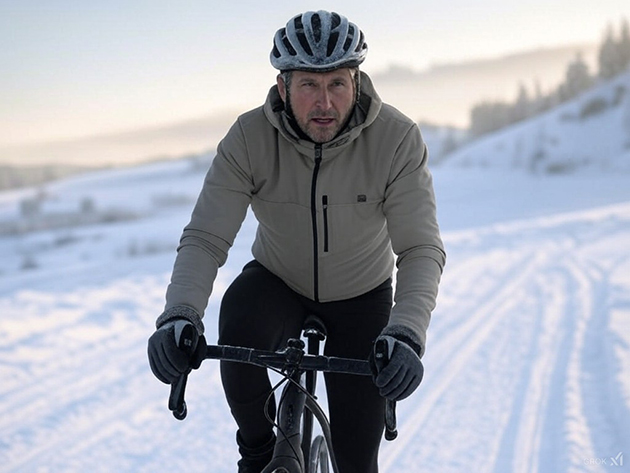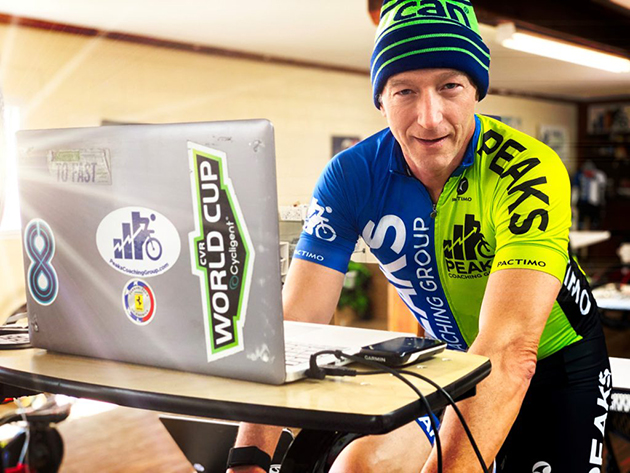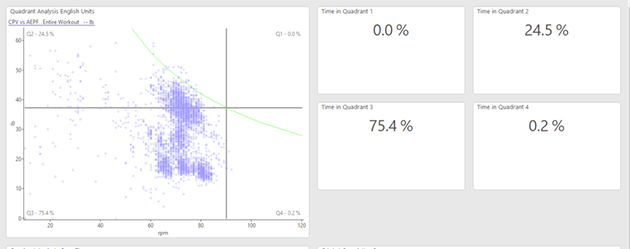

How, and how not, to use an indoor trainer in winter
By PCG Elite/Master Coach David Ertl
Back to list of our training, coaching and nutrition essays

Les Woodland's book Cycling's 50 Triumphs and Tragedies: The rise and fall of bicycle racing's champions is available in print, Kindle eBook & audiobook versions. To get your copy, just click on the Amazon link on the right.
David Ertl writes:
There are many reasons to consider using an indoor trainer in the winter – cold temps, snowy or icy roads, and darkness are the main reasons. Riding outside is great and should be encouraged when possible, but there are times when riding indoors is a better option.
Some people avoid riding an indoor trainer as much as possible and would rather ride outside year-round. They may feel like they are building character (and bragging rights) by riding in frigid weather but how much character does one really need? If it is cold, you are going to basically just be surviving on your bike ride outdoors and what training effect does that give you? Yes, it will give you time in the saddle but are you really working on your fitness? I find riding outside in the cold mentally draining. Not only does it take a long time to get dressed, but suffering through the cold, and dealing with numb toes and fingers takes mental as well as physical energy and I wonder what effect that may have on my motivation by the time summer comes.

On the other hand, I’m not a fan of doing endurance rides on the trainer. 90 to 100 minutes is about the limit for me. Not that I couldn’t go longer physically, but mentally it is taxing. Again, I worry about the motivational implications of this down the road. To get in longer workouts in the winter, I’d encourage you to look for cross-training options: If it’s snowy, consider cross country skiing or snowshoeing. If you can ice skate, that’s another option for using cycling muscles. You can also go hiking, preferably on hilly terrain, in the colder months. In addition, in the winter I do more gym work on strength – both upper and lower body as well as core. This substitutes for some of days I feel I need to do on the trainer.

Make sure your indoor setup is dialed. Fan, table, laptop, towel, kleenex, gels, sports drink. Check out the video below to learn how PCG founder, Hunter Allen sets up his indoor training room.
https://www.youtube.com/watch?v=ho8n0svxgpo
So, here’s my thoughts on how to use the trainer in the winter months. Now, all the training plans you read tell you to do low intensity, high volume in the early season and then shift to more intensity as the race season approaches. But if you live in the north, that is really challenging. You can’t put in your long rides outside, and doing long rides on a trainer is torture. So, here’s an alternate idea. Use the trainer for shorter, but structured rides where you are stimulating your aerobic system. Instead of riding 3-4 hours in zone 2, ride tempo or sweet spot intervals for 1 to 1.5 hours on the trainer. You probably get more benefit doing this than surviving in the freezing cold in zone 2 for 2 hours. My rule of thumb is that if you can’t get in at least 2 hours outside, you are better off doing an hour of structured work indoors where you can get some cardiovascular training accomplished.

An indoor workout like this 30 sec at 120% of FTP and then 30 sec at 60% of FTP is a great workout to enhance your neuromuscular power (L7) and also touch on your FTP(L4). Plus, it's fun and the time goes by quickly!
If you want or enjoy longer rides, especially with the apps like Zwift, My Whoosh, Rouvy or Training Peaks Virtual, you can certainly do so, but I’d caution you to only do those when you are motivated and want to do them. It’s certainly possible to do rides of 2 or more hours indoors but I would caution against doing these too often. I recall the first time I did a smart trainer ride; I rode up Mt Ventoux on Rouvy and rode for 3 hours. It was new, fun and interesting but I haven’t done it since.
Indoor training is especially good for doing structured workouts, especially if they are fairly complex with changing interval lengths and intensities. Structured workouts combined with a smart trainer do the thinking for you and you can just concentrate on doing the work. You can do the intervals without the distraction of vehicles, stop signs, hills or wind. You can do them the same every time and compare with your previous efforts. You can incrementally increase the efforts of your workouts by a couple of watts each time, something that would be very difficult to accomplish on the road.
But something to keep in mind – indoor trainers give you a different sensation than riding on the road. For one thing, you may not realize how much you change power on the road and how much coasting you do outside (unless you study your power files, which you should do), and how much you move around on your bike riding outside vs. staying very stationary indoors. Indoor training doesn’t do anything for balance or bike handling, unless you ride rollers. And the power and muscle dynamics are different on a trainer. You don’t get the same effect of momentum indoors. When riding outdoors, when you stop pedaling or ease up, you keep moving and slow down gradually. On a trainer, if you stop pedaling, you stop within a few seconds.
On a trainer you are always pushing against resistance as if you were riding uphill. Additionally, because you don’t have the same momentum, your pedal stroke is different. You don’t have the same ability to keep momentum of the pedal stroke, especially through the top and bottom dead spots of the pedal stroke. This causes the muscles to work differently. And finally, riding in ERG mode on a smart trainer is a wonderful thing in terms of forcing you to keep a constant power output, but again it is different from pedaling outside. Outside, if you get tired, you may downshift, and your speed and power will drop. In ERG mode, if you get tired the trainer doesn’t let your power drop so what happens is you slow your cadence, but because the power resistance doesn’t change, this causes you to put out more force per pedal stroke at a slower cadence. If this keeps up, you get into a downward spiral, sometimes quite quickly, where you can’t keep up the RPMs, so the resistance gets harder, which causes you to slow your cadence even more and before you know it you are dead in the water.

The blue dots show this cyclist's cadence is too low on the indoor trainer. The vertical line is 90 rpm, so they are between 60 and 85 the whole time. This is the result of the indoor trainer having load across the entire pedal stroke. Get that cadence UP over 85rpm!
In summary, indoor trainers, especially with the advent of smart trainers and training apps, have become a valuable and useful tool for training indoors. Use indoor training to focus on specific power development but realize they aren’t a perfect replacement for outdoor riding. So use indoor trainers wisely and judiciously, balancing indoor training with outdoor training when possible.
Connect with Elite/Master Coach David Ertl this season. He still has a few openings for coaching.








